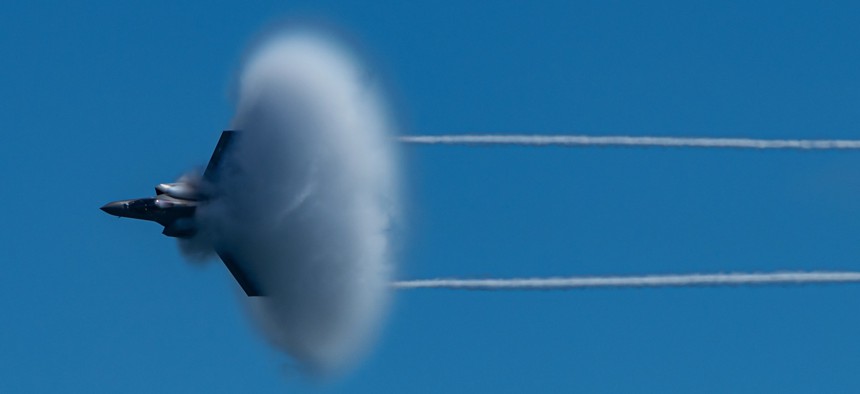
An F-35 tears through the sky during a rehearsal for the 2020 OC Air Show in Ocean City, Md. Air Force Capt. Kippun Sumner
Defense Business Brief: F-35's future, going wobbly?; More M&A; Helo export; and more...
Whither the F-35 in the Pentagon’s warplane plans? House Armed Services Committee Adam Smith became the latest prominent lawmaker to question the stealth fighter’s role. “What does the F-35 give us? Is there a way to cut our losses? Is there a way to not keep spending so much money for such a low capability, because the sustainment costs are brutal,” Smith said at a Brookings Institution event on Friday.
This follows a series of comments by Air Force generals suggesting they need some sort of newly designed fighter jet. Others have touted their desire to accelerate a classified effort to build a next-generation warplane. “What I don’t know...is if our nation will have the courage and the focus to field this capability before someone like the Chinese fields it and uses it against us,” Gen. Mark Kelly, the head of Air Combat Command, told reporters last week.
Even routine Air Force contracts are beginning to look forward to unnamed new aircraft. On Thursday, the service awarded an AMRAAM missile support contract that covers “necessary aircraft lab, flight test, flight clearance and simulation support during all integration requirements in AMRAAM for F-15, F-16, FA-18, F-22, F-35 and other current inventory or next generation platforms that may join the Air Force or Navy inventory before the end of fiscal 2029.” (H/T to Steve Trimble for noticing)
Flashback: Smith was not always so down on the Joint Strike Fighter. At a 2014 Bloomberg event, he said: “The F-35 is the poster child for doing procurement the wrong way, but to the extent possible, they've cleaned up. It will replace 90 percent of fighter aircraft. It's going forward. There's no scenario where we'd scrap it at this point."
Over the past seven years since Smith’s 2014 comments, jet maker Lockheed Martin has cut the F-35’s pricetag, but it currently costs $36,000 per hour to fly the plane — a number Lockheed says it hopes to lower to $25,000 by 2025, something Kelly said he doesn’t expect — and the hundreds of planes already in use will need to go through $12.1 billion upgrades. Plus, the long-term sustainment costs for the Pentagon’s projected 2,456 planes is north of $1 trillion. Meanwhile, problems involving the F-35’s Pratt & Whitney (Raytheon Technologies)-made engine could sideline 5 to 6 percent of F-35 as soon as next year, Defense News reports.
So what does all this mean? The F-35 is the largest, most expensive Pentagon program —ever— so it certainly has a target on its back now that Democrats control Congress and there is a Dem in the White House and are expected to cut defense spending in the coming years. But that’s no easy feat since F-35 parts are made in 45 U.S. states and a number of foreign partners, which will certainly weigh in on the minds of lawmakers. Nine countries are already flying the plane too. “Over the past five weeks, there have been somewhat confusing and conflicting statements about Air Force and DoD reviews of tactical combat aircraft programs,” Byron Callan of Capital Alpha Partners wrote in a March 2 investor note. “The F-35 may seemingly be at risk but, we doubt there’s an impact on deliveries until 2023 or beyond and it's possible that Lockheed Martin emerges as a net winner, depending on the outcome of the reviews and studies, and possible eventual competitions.”
I’ll have a lot more to say about this in the coming weeks and months (and, let’s be honest, probably years).
The mergers and acquisitions keep coming. CAE has agreed to buy L3Harris’ Military Training business for $1.05 billion. The deal “accelerates our growth strategy in Defence and Security and is highly complementary to our core military training business, broadening our position in the United States,” Marc Parent, CAE’s president and CEO, said in a March 1 statement. L3Harris also agreed to sell its combat propulsion systems businesses to RENK AG for $400 million.
Israel said it would buy Sikorsky’s CH-53K, making it the first international customer for the heavy-lift helicopter.
Will Roper, the former head of Air Force acquisition, has joined the board of Red 6, a synthetic air combat training startup.
 From Defense One
From Defense One
Tie US Arms Exports to Values, Pentagon Policy Chief Nominee Says // Marcus Weisgerber
Colin Kahl says sales to Saudi Arabia may change under Biden administration.
AI-Powered Drones Emerge as R&D Priority for Boeing // Marcus Weisgerber
As the company cuts costs in other areas, a new drone flew for the first time last week.
Air Force General: If US Doesn't Hurry to Build New Fighter, China Will // Marcus Weisgerber
A test version of the highly classified Next Generation Air Dominance aircraft flew last year.
DARPA to Hire Biz Execs to Help Its Researchers Take Tech to Market // Mila Jasper
In a cooperative effort with In-Q-Tel, 150 research teams will get funds to help develop go-to-market strategies.
Key Elements Expected This Year for Pentagon's Link-Everything Effort // Patrick Tucker
A second NORTHCOM experiment aims to prove out various concepts for JADC2.
Hyten: US Must Broaden Its Strategic Deterrence Concept — and Keep Its ICBMs // Patrick Tucker
The Joint Chiefs vice chair said a "new strategic defense review" should take account of communications and sensors.
US Unprepared for AI Competition with China, Commission Finds // Mila Jasper
Retaining the current dwindling edge will take White House leadership and a substantial investment, according to the National Security Commission on Artificial Intelligence.
There's a Better Way to Press for NATO Burden-Sharing // John Deni
An assessment of alliance planning for 2014-18 shows what actually gets members to boost collective defense.




